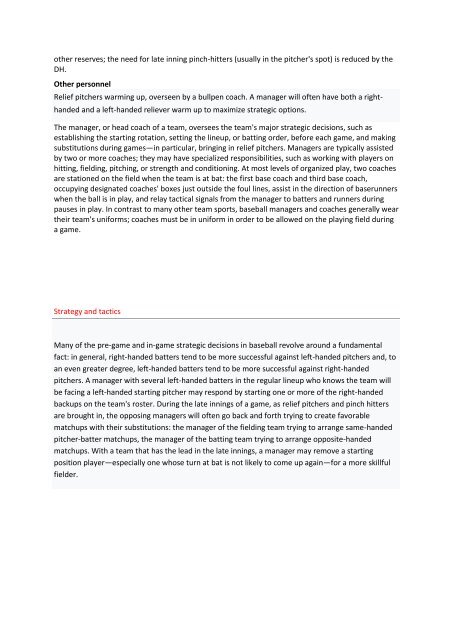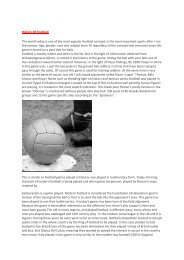Dergi
You also want an ePaper? Increase the reach of your titles
YUMPU automatically turns print PDFs into web optimized ePapers that Google loves.
other reserves; the need for late inning pinch-hitters (usually in the pitcher's spot) is reduced by the<br />
DH.<br />
Other personnel<br />
Relief pitchers warming up, overseen by a bullpen coach. A manager will often have both a righthanded<br />
and a left-handed reliever warm up to maximize strategic options.<br />
The manager, or head coach of a team, oversees the team's major strategic decisions, such as<br />
establishing the starting rotation, setting the lineup, or batting order, before each game, and making<br />
substitutions during games—in particular, bringing in relief pitchers. Managers are typically assisted<br />
by two or more coaches; they may have specialized responsibilities, such as working with players on<br />
hitting, fielding, pitching, or strength and conditioning. At most levels of organized play, two coaches<br />
are stationed on the field when the team is at bat: the first base coach and third base coach,<br />
occupying designated coaches' boxes just outside the foul lines, assist in the direction of baserunners<br />
when the ball is in play, and relay tactical signals from the manager to batters and runners during<br />
pauses in play. In contrast to many other team sports, baseball managers and coaches generally wear<br />
their team's uniforms; coaches must be in uniform in order to be allowed on the playing field during<br />
a game.<br />
Strategy and tactics<br />
Many of the pre-game and in-game strategic decisions in baseball revolve around a fundamental<br />
fact: in general, right-handed batters tend to be more successful against left-handed pitchers and, to<br />
an even greater degree, left-handed batters tend to be more successful against right-handed<br />
pitchers. A manager with several left-handed batters in the regular lineup who knows the team will<br />
be facing a left-handed starting pitcher may respond by starting one or more of the right-handed<br />
backups on the team's roster. During the late innings of a game, as relief pitchers and pinch hitters<br />
are brought in, the opposing managers will often go back and forth trying to create favorable<br />
matchups with their substitutions: the manager of the fielding team trying to arrange same-handed<br />
pitcher-batter matchups, the manager of the batting team trying to arrange opposite-handed<br />
matchups. With a team that has the lead in the late innings, a manager may remove a starting<br />
position player—especially one whose turn at bat is not likely to come up again—for a more skillful<br />
fielder.




